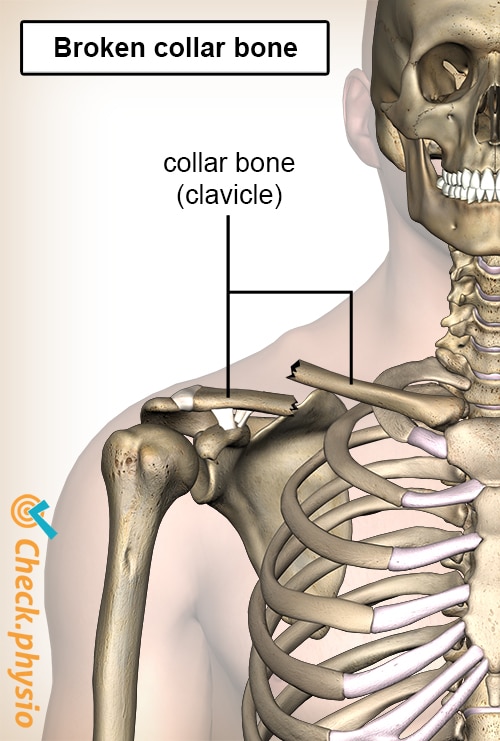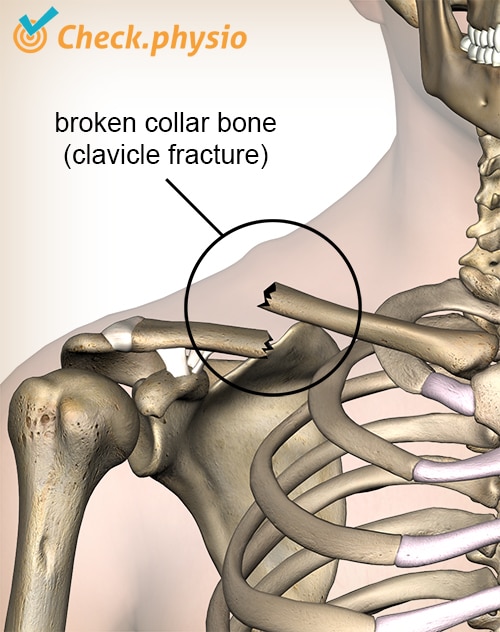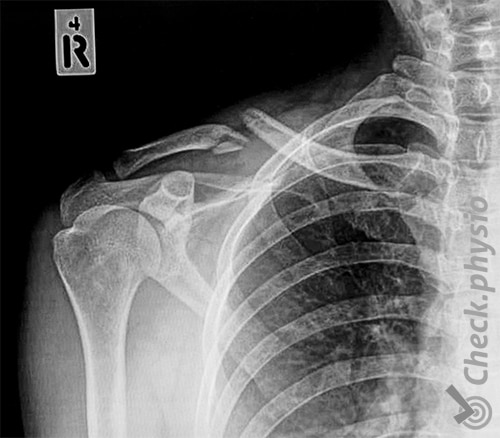Broken collarbone
Clavicle fracture / collarbone fracture
A broken collarbone is one of the most common bone fractures The bone connects the shoulder blade to the sternum. As a result, the collarbone connects the arm to the rest of the body.

The Latin name for the collarbone is the clavicula. That is why, in the medical world, this is often referred to as a clavicle fracture when talking about a broken collarbone.
Description of condition
The collarbone is a long and thin piece of bone that can easily break in an accident or fall. Below the collarbone are a number of important nerves and blood vessels that run into the arm. These structures are rarely affected when the collarbone is broken.
Collarbone fractures are divided into 3 types:
Type 1: Lateral clavicle fracture. The fracture is located on the shoulder end of the collarbone.
Type 2: Mid-shaft clavicle fracture. The fracture is in the middle of the collarbone.
Type 3: Medial clavicle fracture. The fracture is on the sternum end of the collarbone.
Usually, the fracture is in the middle of the collarbone (mid-shaft fracture). Because the ends of the collarbone are connected to the shoulder blade and sternum via strong ligaments, they are less likely to break.
A mid-shaft fracture usually results in a change of position. The fracture causes the collarbone to break in two, so that the part on the inside moves up and the part on the outside moves down underneath it. This displacement is caused by various muscles that are attached to the collarbone and which pull the collarbone upward or downward after a fracture. This causes a thickening at the site of the collarbone.
Gradations
A fracture has several gradations, these gradations say something about the fracture line in the collarbone. We refer to clean fractures when there is one fracture line. For unstable fractures, there are several fractures present which may result in loose bone fragments. Most fractures are clean fractures.
Cause and history
The cause of a broken collarbone is usually a direct fall on the shoulder. Collarbone fractures are therefore common among racing cyclists and mountain bikers. Because they have their feet attached to the pedals, they are at greater risk of falling because they cannot always get their legs to the ground in time.
Falling onto an outstretched arm can also result in a collarbone fracture. This is because the impact of the fall is passed on to the collarbone through the arm. The collarbone is a weaker bone than the arm, which makes it more likely to break.
Signs & symptoms
A fracture of the collarbone will immediately cause a great deal of pain. Due to the pain, it is often impossible to move the arm in the beginning. Symptoms may include:
- Acute severe pain in the shoulder area.
- Inability to lift the arm.
- Drooping arm.
- Swelling in the area of the collarbone.
- A lump or bump in the area of the collarbone (due to the displacement of the two parts).
Diagnosis
A collarbone fracture is not difficult to diagnose due to the location of the collarbone near the surface, making it easy to see and feel. An X-ray is usually done to get an indication of the fracture and the position of the collarbone. This gives insight into the healing process and can help rule out problems with underlying tissues such as nerves and blood vessels.
Treatment
In most cases, a collarbone fracture heals well without surgery. Conservative treatment usually consists of painkillers, rest and physiotherapy. In order to offer the arm and shoulder sufficient rest, a sling is generally used.
Because of the slightly displaced position of the collarbone, shoulder movement may change. By wearing the arm in a sling, the shoulder is often brought forward. In the long run, this does not benefit the shoulder movement. Prolonged use of the sling can also lead to a tightened shoulder. These are unpleasant long-term complications that can easily be prevented by a physiotherapist by keeping the shoulder mobile, with exercise therapy and postural advice.
If, after an X-ray, it appears that the fracture caused too much displacement of the collarbone, or that the fracture is unstable, surgery will be considered.
Exercises
You can check your symptoms using the online physiotherapy check or make an appointment with a physiotherapy practice in your locality.


References
Bahr, R. (2012). The IOC Manual of sports injuries. International Olympic committee, Wiley Blackwell.
Wilk, K.E., Reinold, M.M. & Andrews, J.R. (2009). The atlete's shoulder. Philadelphia: Churchill livingstone. Elsevier.




